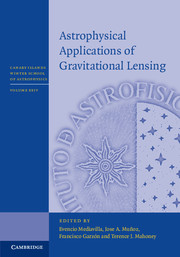Book contents
- Frontmatter
- Contents
- List of contributors
- List of participants
- Preface
- Acknowledgements
- 1 Lensing basics
- 2 Exoplanet microlensing
- 3 Four case studies of microlensing
- 4 Gravitational (micro)lensing of quasars and AGN
- 5 Dark matter in clusters and large-scale structure
- 6 The future of strong lensing
- 7 Methods for strong lens modelling
- 8 Tutorial on inverse ray shooting
- References
4 - Gravitational (micro)lensing of quasars and AGN
Published online by Cambridge University Press: 05 September 2016
- Frontmatter
- Contents
- List of contributors
- List of participants
- Preface
- Acknowledgements
- 1 Lensing basics
- 2 Exoplanet microlensing
- 3 Four case studies of microlensing
- 4 Gravitational (micro)lensing of quasars and AGN
- 5 Dark matter in clusters and large-scale structure
- 6 The future of strong lensing
- 7 Methods for strong lens modelling
- 8 Tutorial on inverse ray shooting
- References
Summary
Active galactic nuclei (AGN) and quasi-stellar radio sources (quasars) are very luminous compact objects at cosmological distances. Right after their discovery in the 1960s, Sjur Refsdal realized that these properties made them ideal targets for determining the Hubble constant with a measurement of the time delay in a gravitationally lensed quasar system. The discovery of the first double quasar Q0957+561 in 1979 (Walsh, Carswell and Weymann 1979) paved the way for monitoring of multiple quasars. Chang and Refsdal (1979) immediately realized that individual stars in a lensing galaxy can act as microlenses and modify the magnification on time scales of years or months. Today, a few hundred gravitationally lensed quasars are known. Time delays have been determined with an accuracy of a few per cent in a few dozen systems. Averaged over an ensemble of lenses, the Hubble constant H0 can be determined with an uncertainty of about 5%, the error budget being usually dominated by the mass model of the lensing galaxy. Uncorrelated fluctuations in the multiple images of a lensed quasar originate from microlensing and contain information on the lensing objects as well as on the quasar luminosity profile and size. Originally, quasar microlensing studies focused on the visual light; more recently, microlensing fluctuations in the broad emission lines have been analysed as well. Microlensing is a natural explanation for the flux-ratio anomaly in some of the quadruply imaged quasars: A smooth dark matter component produces an asymmetric magnification distribution between the two images in a close pair, with a relatively high probability of high demagnification of the saddle point (negative parity) image. Comparison of the observed flux ratios with microlensing simulations even allows us to quantify the most likely dark matter fraction in such systems.
This chapter summarizes the four lectures that the author presented at the XXIV Canary Islands Winter School of Astrophysics in Puerto de La Cruz, Tenerife, which took place over November 4–16, 2012. A very brief introduction to AGN/quasars is followed by a section on the basics of (micro)lensing and the relevant length and time scales. The two main sections then present results on time delay measurements in multiple quasar systems and subsequent determinations of the Hubble constant on the one hand and on various applications of quasar microlensing on the other.
- Type
- Chapter
- Information
- Astrophysical Applications of Gravitational Lensing , pp. 121 - 140Publisher: Cambridge University PressPrint publication year: 2016

